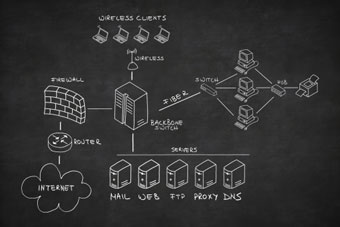To understand what the aftermath of a disaster like HurricaneSandy can do to a credit union look no further than the $1.8billion Municipal Credit Union. In the difficult days following thesuperstorm, MCU members became increasingly frustrated and furious,sharply criticizing the New York credit union for what they saidwere serious lapses and missteps in its disaster recoveryefforts.
|While Hurricane Sandy had a major impact on many credit unionoperations throughout New York's tri-state area, knocking out powerto millions and leaving behind unthinkable devastation, disasterrecovery experts said the MCU experience is a case study thathighlights five major lessons that credit unions should learn fromand avoid.
|What's more, MCU President/CEO Kam Wong explained what thecredit union has learned and what steps it is taking to ensure thedisaster recovery issues don't happen again. Wong also said he issorry about how the post-storm problems affected MCU members.
|Lesson 1: Make Direct Deposit a CriticalFunction
|For nearly a week, members received little or no specificinformation from MCU about why their direct deposits had not beenposted, preventing them from paying bills or get cash they neededto buy necessities to ride out the first difficult days of thestorm's aftermath.
| As this issue festered in the daysafter the storm passed Oct. 29, members grew frustrated, anxious,and angry. They vented many of those feelings by leaving more than70 comments after reading cutimes.com articles that covered the MCUcrisis.
As this issue festered in the daysafter the storm passed Oct. 29, members grew frustrated, anxious,and angry. They vented many of those feelings by leaving more than70 comments after reading cutimes.com articles that covered the MCUcrisis.
“I still haven't gotten my paycheck…I have no money to pay myrent or buy food this weekend,” MCU member Jennifer O. wrote in thecomments section in a Nov. 1 cutimes.com article. “I'm desperateand I don't know what to do! I don't know how to call them, theonly number is this toll free number which does nothing.HELP!!!!”
|This direct deposit debacle caught the attention of Ongoing Operations, a Hagerstown, Md.-based provider forbusiness continuity and disaster recovery solutions for creditunions nationwide.
|Robin Reimes, a business continuity consultant at OngoingOperations, wrote in a recent blog post that many credit unionsoverlook the direct deposit process because it is highly automatedand involves multiple parties. But if credit unions don't recognizedirect deposit as a critical process, it won't be addressed indisaster recovery plans.
|Reimes pointed out direct deposit becomes critical when anatural disaster occurs at or near the time a major payroll isscheduled for processing. In MCU's case, direct deposits werescheduled to be processed on Oct. 29, Oct. 30 or Oct. 31 when muchof New York City was still in the dark. As a result, more than14,000 MCU members didn't receive their paychecks.
|“If your crisis happened on the day a major payroll is scheduledfor process, you and your members will feel the pain much faster,”Reimes wrote in her blog. “Additionally, the longer the outage,your credit union stands an increasingly high risk of losing thosemembers.”
|Reimes recommended that credit unions pick apart the entiredirect deposit process to identify and fix weak spots.
|“Engage in conversations that eliminate disruptions – forinstance, is it possible to 're-run' their last payroll in theevent of a crisis?” wrote Reimes. “Many major payroll providerscurrently do this for companies – why not credit unions? The key topreparedness is plannin and testing alternative deliveryoptions.”
|In response, Wong said the credit union will work with cityagencies that provide MCU payroll information to get that payrollinformation as far in advance as possible, when (weather) forecastspredict impending problems that could impact normal businessoperations. The majority of MCU members are New York City employeeswho are paid from their respective city agencies.
|“In the case of Hurricane Sandy, at the end of Friday, Oct. 26,no one anticipated New York City ordering a mandatory shutdown ofthe city beginning Sunday night in advance of the storm, and thatthe storm would keep most of New York City businesses withoutpower, transportation for as long as it did, so we anticipatedoperating on a normal business schedule,” Wong said. “We also willencourage city agencies to send us their payroll information viaelectronic means instead of the manual process they currentlyuse.” Lesson No.2: Playing the Blame Game Won't Work
|MCU blamed its inability to process direct deposits because itdid not receive payroll data files from agencies in the city of NewYork before the superstorm knocked out power. While the power wasout, MCU said it was working around the clock to manually processthe payroll information to post on members' accounts.
| “My direct deposit is late bythree days,” commented Cannon56. “This is unacceptable by MCU!” Acomment like this from members is why disaster recovery experts sayblaming a problem on someone or something else doesn't work. TheNo. 1 rule of a good crisis management is to acknowledge the issuequickly, tell members what the credit union is doing to fix it andprovide as much information as possible.
“My direct deposit is late bythree days,” commented Cannon56. “This is unacceptable by MCU!” Acomment like this from members is why disaster recovery experts sayblaming a problem on someone or something else doesn't work. TheNo. 1 rule of a good crisis management is to acknowledge the issuequickly, tell members what the credit union is doing to fix it andprovide as much information as possible.
“I think the credit union members probably didn't have all theinformation, but they are also probably right to be upset. Inmy opinion, the credit union really missed an opportunity here toshine for their membership,” said Kirk Drake, president/CEO ofOngoing Operations. “Good crisis management processes can reallyhelp credit unions communicate proactively and honestly withmembers, resulting in building trust and brand value. Ingeneral, blaming anyone in a disaster probably won't really helpthe situation and will do more harm than good.”
|But Wong insisted that MCU did not blame the entire problem onsomeone.
|“This problem impacted about 14,000 members, and while that is avery small percentage of our close to 300,000 members with directdeposits, we are sorry it impacted even one member,” said Wong.“The difficult challenge for us was that we didn't learn aboutthese missing payrolls until our staff, working at our disasterrecovery site manually posting credits to accounts, realizedinformation was missing. We informed our members then, but we dounderstand the frustration some members felt when an expecteddeposit was not seen when they checked their balances online.”
|Even though MCU had covered these deposits and postedinformation explaining that the deposits were delayed and why, Wongconcedes that MCU should have posted a more comprehensive messagewith recommendations to members, which was to go to an MCU branchand see the branch manager.
|Branch managers were authorized to look up direct deposithistories, and if the expected last one was not credited due to thestorm, MCU was honoring those deposits and honoring withdrawals ofup to $800 a day even though the credit couldn't confirm that moneywas in members' accounts, Wong said. Lesson No. 3: Backup Systems CUs MustHave: Phone, Email and Website
|The three most important services all credit unions must have ina disaster recovery plan is to absolutely, positively have backuptechnology that will ensure the credit union's email, phone andwebsite keep working.
| “If you don't have these three,your members have no idea how to get a hold of your credit unionany other way and they cannot get information,” Drake said.
“If you don't have these three,your members have no idea how to get a hold of your credit unionany other way and they cannot get information,” Drake said.
What drove up concern and anxiety among MCU members is that theycould not call their credit union to find out what was happening orget any updates. Without power, MCU said it could not operate itscall center for nearly a week.
|The credit union did establish another number for members tocall. However, members complained the number connected only to arecording of branches that were open. Some members managed tocontact the branches that had reopened Oct. 31, but some complainedthey didn't get any answers. Members also complained they sent MCUemails that were not answered.
|“I can't reach MCU over the phone because they have no oneanswering,” wrote another MCU member, “Pissed Off.” “I've no foodor money and no one from MCU is letting me know anything.”
|So how did some credit unions manage to stay operating despitethe superstorm devastation?
|For the credit unions that already were prepared, with solidplans in place, everything was relatively calm, Scott Collins, president of Grand Rapids, Mich.-based CUSO XtendInc., said in a Nov. 14th Credit UnionTimes article. Xtend provides disaster recovery services tofive New York City-based credit unions and one in New Jersey. “Noneof our credit unions lost a minute of uptime on electronicchannels,” said Collins, who acknowledged they all had limited orno branch services, primarily due to lack of power.
|For one credit union, Progressive Credit Union, the $540 millionManhattan institution known for its portfolio of taxi medallionloans, “we provided phone answering services,” said Collins whoindicated Progressive has a contract in place with Xtend where theCUSO, as needed, steps in and answers inbound phone calls with theaim of providing members with questions full and accurateanswers.
|Even though MCU had a disaster recovery plan in place, Wong saidhis credit union certainly did learn another lesson from HurricaneSandy.
|“Our biggest challenge was telecommunications. We learned weneed to have more than one telecommunications provider,” Wong said.“Although our post-9/11 disaster recovery plan worked, the onething that was problematic was that we still relied on one providerfor our phone and data lines and many telecommunications hubs weredamaged due to this unprecedented storm affecting the majority ofbusinesses and homes in our area.
|“In the future, we will have two, if not three, providers sothat the back up is on a different system and we will havealternatives for customer service lines and data communications. Weare already working on this.” Lesson 4:Your Hot Site Should Not Be Within Driving Distance Of YourHeadquarters
|When 9/11 devastated lower Manhattan – the business andgovernment center of New York City where MCU has its headquarters –many businesses decided to move their disaster recovery hot siteshundreds of miles away.
| “If you look at any majororganization that got hit during 9/11, they moved their DR sites tonorthern Virginia, Charlotte, N.C., or any place not in the NewYork tri-state area,” said Drake.
“If you look at any majororganization that got hit during 9/11, they moved their DR sites tonorthern Virginia, Charlotte, N.C., or any place not in the NewYork tri-state area,” said Drake.
After 9/11, MCU moved its DR site from Malvern, PA.,(outside Philadelphia) to Carteret, N.J., which is about 22 milesfrom MCU's headquarters, or about a 35-minute drive. NewJersey suffered the brunt of Hurricane Sandy's destruction as wellas widespread power outages.
|“My gut tells me is that MCU desperately needs to update theirdisaster recovery planning,” said Karen Jaworski, senior directorof product marketing for EVault Inc. in San Francisco, a providerof backup and recovery services. “They continue to go at disasterrecovery planning with a 20th century methodology, whichis not right for today.”
|You'll get no argument about that from MCU member, YazeemCollazo, who wrote: “NY MCU is antiquated and should have learnedfrom 9/11 that contingency plans are ESSENTIAL in a crisissituation – especially when you're responsible for millions ofdollars.”
|Jaworski explained that many businesses developed their disasterrecovery plans in part on the generally accepted best practice oflocating backup servers far away enough from a company's mainservers to avoid simultaneous loss, but not too far away for timelydisaster recovery. But because superstorms like Hurricane Sandy canenvelope entire regions of the country, having backup serverswithin driving distance may no longer be a good disaster recoverypractice.
|“Sandy is the biggest storm we've seen, and it's probably notgoing to be an isolated incident,” said Jaworski. What's more, itmay be difficult to corral enough employees to work on disasterrecovery efforts when they and their families, too, have beenimpacted by a storm.
|That's why more businesses are considering cloud computing andvirtualization solutions that remove the need for companies tomaintain backup servers or other hardware, said Jaworski.
|Virtualization makes it very easy to back up informationremotely through virtual private networks, said Jaworski. Whenvirtualization is combined with cloud computing, it enablescompanies to move data far enough away from harm's way.
|“Your data does not have to be within a driving distanceanymore,” Jaworski said. “It could be all the way on the other sideof the country or in another country if that is what you wanted todo.”
|However, Wong said MCU's disaster recovery site was not theproblem; it was, instead, the telecommunications system.
|“Our disaster recovery site, which is the same one used by theU.S. Army and many Fortune 500 companies, was safe and functional;we had staff working at the site the day after the hurricane hit,so in this instance, the location of our site did not impact ourrecovery efforts,” Wong said. “Our problem was in thetelecommunications, which meant our staff at the disaster recoverysite had to manually put in all the information that had beenbacked up on the servers in our disaster recovery site, and it alsomeant that our customer service phone lines were down. But weintend to assess every part our disaster recovery plan and responseto determine ways we can do things better. You always learn fromevery new situation and we will learn and improve from this one. Lesson 5: Communicate…..Communicate….and Communicate some more
|Frustrated over not getting enough information about what washappening with their credit union, some MCU members searched onGoogle and found the cutimes.com articles.
| “MCU communications with itscustomers affected by this should be updated more frequently thanit has been,” reads one comment by Silntdrgn 7. “I and many othershave to search all over the Internet just to get updates and findout what happened. If it (wasn't) for the reports here, many of uswouldn't know anything. How about at least using the CUT to updatemembers every few hours on where things stand?”
“MCU communications with itscustomers affected by this should be updated more frequently thanit has been,” reads one comment by Silntdrgn 7. “I and many othershave to search all over the Internet just to get updates and findout what happened. If it (wasn't) for the reports here, many of uswouldn't know anything. How about at least using the CUT to updatemembers every few hours on where things stand?”
On a phone line set up after the superstorm, a recorded messagetold members which branches were open. Three days after the storm,Wong posted a letter to members on the credit union'swebsite.
|In that letter, Wong expressed empathy for members and theirfamilies, offered member assistance such as emergency credit lineincreases, and said employees were working around the clock toreopen closed branches. However, he did not mention the directdeposit problem even though MCU members had already publicly postedcomplaints on cutimes.com about the direct deposit issue,inoperable ATMS and no access to MCU's call center.
|Wong did acknowledge the direct deposit issue in his secondletter to members Nov. 6. By then, however, power hadbeen fully restored in lower Manhattan, enabling MCU to process thepayrolls. However, sometime before Wong's second letter, MCU didpost a notice on its site about the direct deposit problem and thatit was working to fix it.
|Nonetheless, many members said they were upset because theyreceived no emails or texts messages. What's more, because MCUdoesn't have a Twitter or Facebook site, it wasn't able to leveragethe popular social media channels to communicate with members asother credit unions did throughout the tri-state area.
|“You have to regularly and proactively provide as muchinformation as you can,” said Drake. “The quicker you can getinformation out there, the less things fester and become ugly. Whenyou do that you build trust in that environment.”
|Wong said he is sorry that members felt they did not have theinformation they needed and he pledged to work to bettercommunicate news in the future.
|“We put information on our website and we ran full-page ads inlocal newspapers this time, but we will look to do even more in thefuture, providing more frequent updates and also using as manycommunications vehicles as viable,” said Wong.
|Next Steps:
|||Complete your profile to continue reading and get FREE access to CUTimes.com, part of your ALM digital membership.
Your access to unlimited CUTimes.com content isn’t changing.
Once you are an ALM digital member, you’ll receive:
- Critical CUTimes.com information including comprehensive product and service provider listings via the Marketplace Directory, CU Careers, resources from industry leaders, webcasts, and breaking news, analysis and more with our informative Newsletters.
- Exclusive discounts on ALM and CU Times events.
- Access to other award-winning ALM websites including Law.com and GlobeSt.com.
Already have an account? Sign In
© 2024 ALM Global, LLC, All Rights Reserved. Request academic re-use from www.copyright.com. All other uses, submit a request to [email protected]. For more information visit Asset & Logo Licensing.









